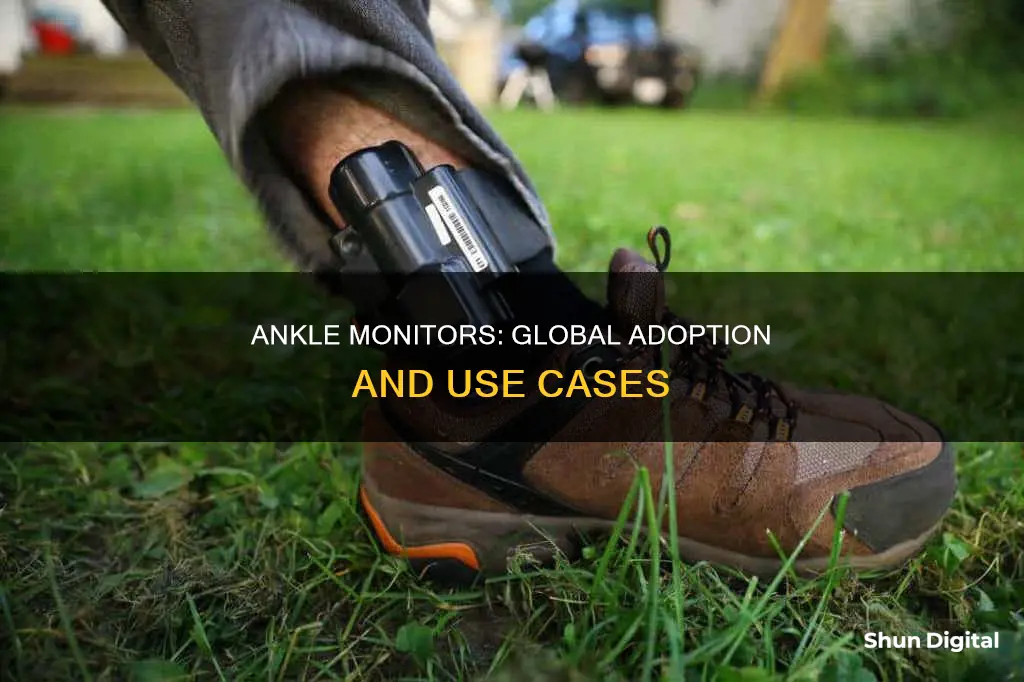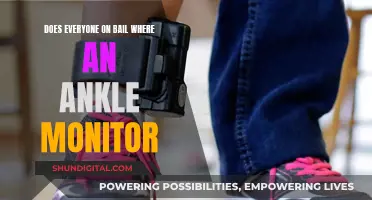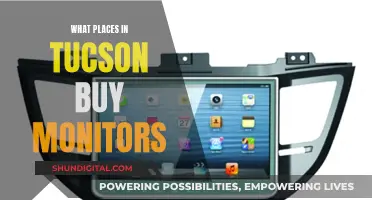
Ankle monitors are a form of electronic tagging used for surveillance. They are often used as an alternative to detention, with the wearer's location being tracked by GPS. In the US, Immigration and Customs Enforcement (ICE) uses ankle monitors as part of its 'Alternatives to Detention' program, which has been criticised for causing physical and mental harm to immigrants. Other countries that use ankle monitors include Brazil, South Africa, Australia, and New Zealand.
| Characteristics | Values |
|---|---|
| Countries that use ankle monitors | United States, Brazil, South Africa, Australia, New Zealand, England, Wales |
| Use cases | People on bail or probation, immigrants, those in healthcare settings, sex offenders, psychiatric and dementia patients |
| Ankle monitor features | GPS tracking, radio frequency technology, pre-programmed audio messages, electric shocks |
| Ankle monitor impact on wearers | Inflammation, severe cramps, bleeding, sores, numbness, impaired circulation, excessive heat, swelling, social isolation, stigma, loss of employment opportunities |
| Ankle monitor cost | $4.50-$20 per day for low-cost programs; Intensive Supervision Appearance Program (ISAP) costs $5 per day per immigrant |
What You'll Learn
- The US uses ankle monitors on immigrants awaiting court proceedings
- Ankle monitors are used in the UK for those on bail or probation
- Brazil uses ankle monitors to monitor offenders
- South Africa uses ankle monitors to reduce prison populations
- New Zealand allows the use of ankle monitors for bail, probation, or parole

The US uses ankle monitors on immigrants awaiting court proceedings
Immigration and Customs Enforcement (ICE) has been issuing thousands of 5.5-ounce ankle monitors to immigrants, which has led to mixed reactions. While the government argues that these devices ensure immigrants show up for their immigration court proceedings, advocacy groups and legal experts argue that they are inappropriate and inhumane for people seeking asylum.
The ATD program was first established by Congress in 2002, and the use of GPS monitors increased significantly in 2014 when thousands of unaccompanied minors and families arrived at the US-Mexico border, fleeing violence and seeking asylum. As of July 2024, there were nearly 84,500 active participants in ICE's ISAP program, with around 45% issued GPS monitors.
The use of ankle monitors on immigrants has been a divisive issue. On the one hand, they are seen as a more cost-effective alternative to detention, with ICE spending significantly less per day on ATD programs compared to immigration detention. Additionally, these programs have proven to be highly effective in ensuring immigration court attendance, with success rates exceeding 90%.
However, there are also concerns about the negative impacts of ankle monitors on immigrants. These devices impose significant restraints on the wearer's freedom of movement and have been associated with physical discomfort, social stigma, and psychological effects. The stigma of wearing an ankle monitor can also limit employment opportunities, as potential employers may associate the device with criminal activity. Furthermore, there are privacy concerns about the data collected through these monitoring programs and how it is shared and stored.
While the use of ankle monitors in the US has been presented as a more humane alternative to detention for immigrants awaiting court proceedings, it is clear that there are complex ethical, social, and legal considerations surrounding their use.
Removing Monitors from the Extreme Mystery Aristocrat Machine
You may want to see also

Ankle monitors are used in the UK for those on bail or probation
In the UK, the use of ankle monitors has been a controversial topic, with some arguing that it is a more effective punitive measure than fines or community service. On the other hand, critics argue that ankle monitors infringe on personal liberties and can cause psychological and physical harm to the wearer. There have also been concerns about the cost of the ankle monitor program and the involvement of private companies in the surveillance process.
The use of ankle monitors in the UK is not limited to the criminal justice system. Ankle monitors have also been used in healthcare settings, particularly for elderly individuals with dementia, to prevent them from wandering away. However, this practice has sparked debates about patient safety, privacy, and human rights.
In addition to their use in the UK, ankle monitors are utilized in several other countries for similar purposes. In the US, the use of GPS ankle monitors has been on the rise, with wearers describing them as "digital shackles" that restrict their movements and freedoms. Australia and New Zealand have laws permitting the use of ankle monitors as a condition for bail, probation, or parole, with the surveillance proportional to the risk of reoffending. Brazil has also implemented a GPS offender monitoring program as part of its early release initiative.
While ankle monitors are touted as a way to reduce prison populations and provide alternatives to detention, there are ongoing debates about their effectiveness in preventing reoffending and protecting the public. Additionally, the financial burden associated with ankle monitors and the involvement of private companies in their implementation have sparked criticisms and legal challenges.
Backlit Battle: LED vs LCD Monitors Explained
You may want to see also

Brazil uses ankle monitors to monitor offenders
Brazil has implemented the use of ankle monitors as a means of tracking and monitoring offenders. In August 2010, the country awarded a GPS Offender Monitoring contract to initiate the surveillance of offenders and to manage its early release programme. This move was part of a broader effort to reduce the number of prisoners in state cells, which, at the time, accounted for 88.9% of the over 832,000 incarcerated individuals in Brazil.
The use of ankle monitors in Brazil has been associated with the reduction of its prison population. In 2022, the number of people under electronic monitoring in the country, commonly referred to as ankle monitors, reached 91,632. This figure represented 11.1% of prisoners in Brazil, including those in federal facilities. The rise in the use of ankle monitors can be partly attributed to a recommendation by the National Council of Justice (CNJ) to reduce the risk of COVID-19 infection among detainees during the pandemic.
The implementation of ankle monitors in Brazil has sparked discussions and raised questions about their effectiveness and impact. While some argue that these devices offer an alternative to incarceration and help reduce prison populations, others express concerns about their potential negative consequences. Critics argue that ankle monitors may hinder individuals' efforts to rebuild their lives after prison and that there is a lack of evidence supporting their rehabilitative value.
The use of ankle monitors as a surveillance tool is not unique to Brazil. Countries like the United States, England, Wales, New Zealand, and Australia have also employed this technology in various contexts, including criminal justice, immigration, and healthcare.
Acer Predator Monitors: Worth the Investment?
You may want to see also

South Africa uses ankle monitors to reduce prison populations
South Africa has one of the largest prison populations on the African continent. To reduce this number, the country began a pilot project in 2012 involving 150 offenders, mostly prisoners serving life terms. The project was rolled out to reduce the prison population and, consequently, reduce the taxpayer's burden on correctional facilities.
The use of ankle monitors in South Africa is part of the country's electronic monitoring (EM) system, which has been implemented in various countries around the world. EM is a form of surveillance that uses electronic devices, such as ankle bracelets, to monitor an individual's movements outside of a prison or detention centre. This system can be used in combination with the Global Positioning System (GPS) to track an individual's location. Alternatively, radio frequency technology can be used for short-range monitoring.
The expansion of EM has been accelerated by the COVID-19 pandemic, as governments aim to reduce prison populations due to health concerns. In the Netherlands, for example, 200 nonviolent inmates were released with electronic monitoring equipment during the pandemic. This trend is not limited to Europe, as thousands of inmates in the United States have also been placed under home confinement with ankle monitors.
While EM has been praised for its potential to lower criminal justice costs, decrease prison populations, and reduce recidivism, it has also faced criticism. Some argue that it adds an unnecessary layer of surveillance and reinforces social stratification, creating a subgroup of second-class citizens. Additionally, there are concerns about the financial burden placed on inmates and their families, as well as the potential for technical failures and false alarms. Despite these criticisms, South Africa's implementation of ankle monitors as a means to reduce its prison population aligns with a global trend towards utilising technology for community control and surveillance.
Identify Your Thunderbolt Monitor: A Step-by-Step Guide
You may want to see also

New Zealand allows the use of ankle monitors for bail, probation, or parole
New Zealand permits the use of ankle monitors for bail, probation, or parole. The New Zealand Department of Corrections is responsible for managing electronic monitoring as a condition of bail, which is granted to defendants who would otherwise be remanded in custody while awaiting a court hearing. Defendants on bail are required to wear an electronically monitored anklet and live at an address approved by the Court. The Department of Corrections also handles instances of non-compliance with bail conditions, such as attempting to remove the anklet, leaving the approved address without permission, or returning late from a planned absence.
The Court or the New Zealand Parole Board may impose electronic monitoring as part of an offender's sentence or order. This entails wearing a tracker on the ankle 24 hours a day, seven days a week, and having a monitoring unit installed at the home address. The probation officer plays a crucial role in this process, explaining the sentence or order details and providing additional information. They also define the electronically monitored boundary, which is the area the offender must remain within during their curfew.
In the context of parole, the New Zealand Parole Board can impose electronic monitoring as part of parole or extended supervision orders. Parole with residential restrictions can be either full or partial, with electronic monitoring implemented 24/7 or during specified curfew times, respectively. The Probation Officer is responsible for managing the sentence or order, conducting regular home visits, and providing support to address offending behaviour.
Propping Up Your ASUS Portable Monitor: A Step-by-Step Guide
You may want to see also
Frequently asked questions
Ankle monitors are used in the US, UK, Brazil, South Africa, Australia, and New Zealand.
Ankle monitors are electronic devices that can be used in combination with the Global Positioning System (GPS) to track an individual's location. For short-range monitoring, radio frequency technology can be used.
Ankle monitors are typically used by law enforcement and immigration agencies to track individuals who are on bail, probation, or parole. They can also be used in healthcare settings, such as for patients with dementia to prevent them from wandering.
Research suggests that ankle monitors are effective in reducing the likelihood of individuals absconding or re-offending. However, critics argue that they can cause psychological and physical harm, interfere with daily life, and lead to increased surveillance and stigma.
Alternatives to ankle monitors include GPS-enabled smartphones, electronic bracelets, and other forms of electronic monitoring. In some cases, individuals may be subject to curfews, house arrest, or community service instead of ankle monitoring.







